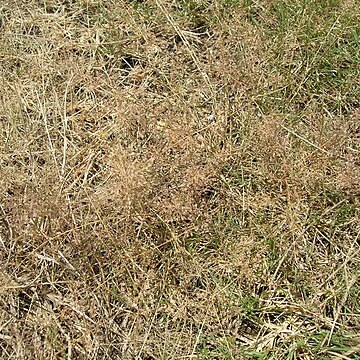Tufted annuals. Culms erect or ascending, (6–) 9–25 (–60) cm high. Leaves often pilose; ligule a fringe of hairs, 0.2–0.3 mm long; blade flat or loosely involute to folded, to 9 cm long, to 3.5 mm wide, ±stiff. Panicles open, 3.5–14 cm long, 0.8–5.5 cm wide, scaberulous; axils sometimes pilose; branches simple or divided, filiform, sometimes sparsely glandular, naked near axil. Spikelets pedicellate, terminated by vestigial floret or naked rachilla internode, oblong to ovate, compressed, 1–2.3 mm long, 1–2.5 mm wide; rachilla flexuose, slender; florets 4–7, loosely overlapping. Glumes deciduous, unequal, ovate, ±hyaline, often with keel green; lower glume 0.5–0.6 mm long; upper glume 0.7–1 long. Lemma ovate-oblong, 0.7–1 mm long, obtuse, sometimes mucronulate, membranous; lateral nerves ribbed, often green; lower lemmas sometimes falling separately. Palea membranous; body spathulate; keels stiffly ciliate; flaps almost as wide as body. Stamens 3; anthers c. 0.2 mm long. Grain not compressed, narrowly ovoid or ellipsoid, c. 0.5 mm long, ±acute at apex and base, glossy, dark reddish brown.
More
Annual; culms slender, erect or geniculate-spreading, 10-40 cm. high; blades flat, 4-10 cm. long, 2-4 mm. wide, acuminate, glabrous; sheaths glabrous, with a promi-nent tuft of hairs at the throat; panicles oblong, 3-12 cm. long, 1.5-3 cm. wide, the short branches stiffly ascend-ing or spreading, 1-2.5 cm. long; spikelets mostly 1.5-2 mm. long, 4-to 6-flowered; lemmas 1 mm. long, obtuse, the palea conspicuously ciliate, the hairs about 0.3 mm. long.
A delicate annual grass. It forms tufts. It grows 30-60 cm high. The leaf blades are flat and 2-10 cm long by 0.5 cm wide. The seeds are oval and red and 0.5 mm across.
In sand on river banks, lake-shores and coastal dunes; also in Kalahari Sand and as a weed of disturbed ground and cultivation, at elevations up to 1,160 metres.
More
A troublesome weed of gardens, lawns androadsides; usually in sandy soils but also in beach sands, woodland clearingsand shallow soils over laterite.
It is a tropical plant. It grows along roadsides and on cultivated land across Africa and in Asia. It grows in savannah woodland. In Yunnan.

